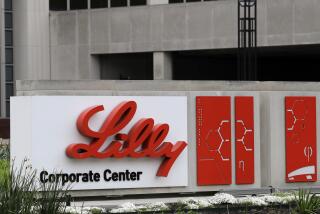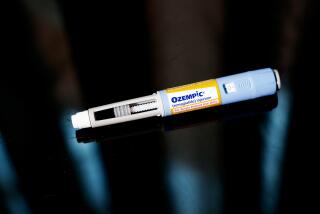Column: Lilly unveils a ‘generic’ insulin and shows how broken our healthcare system really is

Drugmaker Eli Lilly patted itself on the back this week for offering an “authorized generic” version of its Humalog insulin for about half the current list price.
“Solutions that lower the cost of insulin at the pharmacy have been introduced in recent months, but more people need help,” said David A. Ricks, the company’s chief executive. “We’re eager to bring forward a low-priced rapid-acting insulin.”
Well, no.
What Lilly and other drug companies are eager to do is keep lawmakers and regulators at bay amid growing outrage over the exorbitant prices charged for name-brand prescription meds.
In this case, all Lilly is doing is following the same crisis-management playbook as fellow pharmaceutical pirate Mylan, which introduced an authorized generic version of the EpiPen after being pilloried for having jacked up the price of the life-saving device by 500%.
Both companies in reality are trying to have their cake and eat it too.
The in-house generic allows them to gain the PR benefits of making a discount version of a drug available to people who otherwise couldn’t afford it.
At the same time, it avoids the unpleasantness of an honest-to-goodness price cut of its name-brand drug, which would raise questions about all its pricing decisions and scare the bejeepers out of shareholders, who rely on overpriced medicine as a profit driver.
All Lilly has done, in other words, is maintain the status quo in an industry that freely, and aggressively, gouges the most vulnerable members of society.
“By offering a generic version, it allows Lilly to fend off the criticisms,” said Andrew Ching, a professor at Johns Hopkins University’s Carey Business School. “By keeping the branded version, it allows them to keep charging a high price to the segment of consumers who are willing to pay more.”
Who would be willing to pay more? Ching said this might include patients who aren’t sure about the quality of a generic alternative, even when that generic is based on the same formula and is made by the same company manufacturing the original.
It also might include the very same insurers and pharmacy benefit managers that complain loudly about high drug prices. Why? Because they frequently receive kickbacks from drug companies in the form of rebates that allow them to share in the ill-gotten profits.
These aren’t the same rebates consumers might receive in discount programs. They’re paid to the insurers and PBMs, which theoretically could pass them along to patients in the form of savings.
Unfortunately, that’s seldom the case.
“The PBMs are getting, and mostly pocketing, branded drug rebates that may be even larger than the 50% authorized generic price reduction,” said Joel W. Hay, a pharmaceutical economist at USC.
Ricks, the Lilly CEO, is performing an act of misdirection.
Don’t look at all those skeevy prices and rebates, he seems to be saying. Look instead at what a splendidly humanitarian thing we’re pulling out of our hat.
“For people with diabetes,” Ricks said, “a lower-priced insulin can serve as a bridge” to improved healthcare.
As it happens, I’m one of those people with diabetes — Type 1, the autoimmune kind — and I rely on Lilly’s Humalog to keep me alive. So I have a personal interest in the company’s pricing and posturing.
Greg Kueterman, a Lilly spokesman, told me the company’s generic version is intended to assist not just people without insurance but also patients with high-deductible plans who are forced to pay the list price for insulin until their deductible is met.
“The lower-priced version can help fill important gaps for the uninsured, the underinsured and people on Medicare Part D, meaning no one needs to pay the full Humalog list price,” he said.
Let’s hit the pause button there.
A drug company is essentially saying it deserves praise for preventing people from paying the full list price it sets for its own drug.
Am I the only one who recognizes how crazy that sounds?
Isn’t Lilly openly acknowledging that its list price is unconscionable and unethical, and that people need to be protected from such rapacious corporate practices?
Kueterman also said that “cutting the list price would significantly disrupt patients whose current insurance plan covers Humalog.”
This, too, is remarkable. Lilly appears to be defending the current system of pricing drugs at astronomic levels so that various industry players can wet their beaks.
The suggestion is that if Lilly lowered the list price for Humalog, greedy PBMs and insurers wouldn’t get their accustomed piece of the action, and would retaliate by moving Humalog to a higher-priced coverage tier, thus causing the “disruption” Kueterman warned of.
Federal officials have focused on the insulin market because worldwide sales are controlled by just three companies — Lilly, Novo Nordisk and Sanofi — and prices for a drug discovered about a century ago have been steadily rising for no good reason (other than profiteering).
Yes, there have been advances in terms of how fast and efficiently insulin works. But that doesn’t justify dozens of price hikes in recent years.
A 2016 study in the Journal of the American Medical Assn. found that the estimated annual cost of insulin per patient nearly tripled over 11 years, to $736 in 2013 from $231 in 2002.
When Humalog was introduced in 1996, it cost $21 a vial, which is about a month’s supply for many people with diabetes. The list price is now approaching $300 a vial.
Lilly’s answer apparently is to declare it has now done its share to remedy things.
“The current system operates under a rebate model, and health plans can use rebates to reduce premiums for all members of their plan or fund other priorities,” Kueterman told me. “But they don’t always directly pass on to patients the rebates they receive.”
No, they don’t. That bit about “other priorities” often seems more important than lowering prices or premiums.
If drug companies want to be part of the solution, rather than part of the problem, they should lead the way in simplifying our healthcare system so that patients can obtain affordable medicine that still provides manufacturers with a reasonable return on their investment.
Perhaps they can throw their considerable weight behind allowing Medicare to negotiate drug prices on behalf of its 57 million beneficiaries, thus introducing much-needed transparency and consistency to the market, and making profit-hungry PBMs largely obsolete.
As a Humalog user, I will agree with Lilly that a generic version is indeed a step in the right direction. Any generic alternative to an overpriced name-brand med is a good thing.
But tell me again why the cost of a vial has risen by more than 1,200% since the mid-1990s.
Tell me again why my chronic disease should be such an important part of Lilly’s $3.2 billion in profit last year.
Tell me again how “eager” you are to help.
David Lazarus’ column runs Tuesdays and Fridays. He also can be seen daily on KTLA-TV Channel 5 and followed on Twitter @Davidlaz. Send your tips or feedback to [email protected].
More to Read
Inside the business of entertainment
The Wide Shot brings you news, analysis and insights on everything from streaming wars to production — and what it all means for the future.
You may occasionally receive promotional content from the Los Angeles Times.











